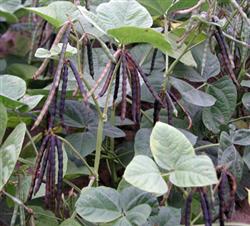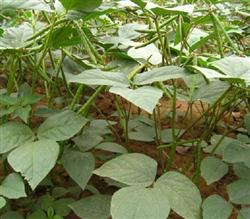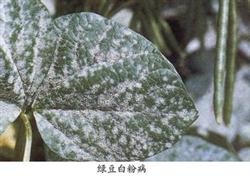high-yield cultivation technique of mung bean (II)

Fifth, timely shoveling and topdressing. At present, the investment in mung bean production is less, the management is extensive, and the yield level is low, so field management should be strengthened. Especially in the seedling stage, mung bean grows slowly and is easy to be bullied by grass, which affects the growth and development, and the management should be more timely. During the growth period, it is generally necessary to carry out three times of ploughing and weeding before blooming and bearing pods (three shovels and three times). In line with the principle of shallow-deep-shallow, three shovels should be carried out three times. Mung bean topdressing is best carried out at flowering stage combined with ridge sealing. Per hectare, nitrogen fertilizers such as ammonium nitrate and urea can be applied 45 kg per hectare, and potassium sulfate 100 kg to 120 kg. In the barren plots, extra-root topdressing can be carried out during the podding period, and 0.4% potassium dihydrogen phosphate solution is sprayed on the leaves at 500kg / ha to 1000 kg / ha, resulting in an obvious yield increase. 6. although timely irrigated mung beans have strong drought resistance, they need more water during the flowering and podding period. if they encounter drought, that is, when the soil field capacity is less than 50%, they should be irrigated in time to prevent falling flowers and pods and reduce yield. 7. Pest control. 1. Pest control. During the whole growth period, especially in the early stage, attention should be paid to the control of aphids, red spiders and other insect pests, such as spraying omethoate EC, aldicarb, enemy killing and other pesticides. 2. Disease control. In the production of mung bean in our city, the common diseases in recent years are leaf spot, downy mildew, Sclerotinia sclerotiorum and so on. (1) Prevention and control of leaf spot. Leaf spot disease harms the stems, leaves and pedicels of mung bean. It is a serious disease of mung bean. The yield can be reduced by 10% to 30%. In serious cases, it can reach more than 50%, and the quality is seriously degraded. The pathogen of leaf spot overwinters on soil and plants. In the second year, the pathogen propagates on plants and spreads by wind, rain and seeds. Mung bean can occur at seedling stage, and the severity of the disease is closely related to temperature and humidity. The air temperature is high (25 ℃ ~ 28 ℃) and the air humidity spreads quickly when the air humidity is 85% ~ 90%. The main control methods are as follows: ① rotation. It can reduce the host of pathogens, which is a very effective control method. ② applied more potash fertilizer. The application of chemical fertilizer and organic fertilizer containing potassium can enhance the resistance of mung bean to leaf spot and reduce the damage degree. ③ chemical control. In the early stage of the disease, Bordeaux liquid and other agents were sprayed for prevention and treatment. After that, the spread of the disease can be controlled every 7-10 days, usually 3 times in a row. It can also be sprayed with 80% wettable Dysenxin 400 times or 50% carbendazim wettable powder 800-1000 times, each time 750 kg / ha. (2) Control of downy mildew and Sclerotinia sclerotiorum: these two diseases also occur frequently and are seriously harmful. Especially in the later stage of the growth and development of mung bean, in case of continuous rain, the year with high air humidity occurs more seriously. They are also soil-borne or seed-borne diseases. The main methods of control are rotation and seed treatment, but there is no effective method of chemical control at present. Eighth, the pods harvested in time are not mature, and the pods are easy to burst and lose grains. Therefore, in order to prevent the yield reduction caused by shedding loss, more than 80% of the pods should be harvested in time before the dew goes down in the morning. When cultivated in a small area, pods can be harvested by stages. After harvest, mung beans should be dried and threshed in time, and stored in storage after chemical treatment.
- Prev

Strain technique of fertilization in mung bean
Mung bean is the main crop in our city, with an annual planting area of more than 1 million mu and an output of more than 110000 tons, accounting for more than 30% of the annual output of mung bean in the country. Baicheng mung bean has become a popular business in the international market because of its large grain, full grain, bright color, bright green, no miscellaneous color, no pollution, high protein content and so on.
- Next

Mung bean mothproof method
Symptoms: mung bean powdery mildew harm leaves, stems and pods. Leaves damaged, scattered white powdery mildew spots on the surface, when the climate is appropriate, the diseased leaves are covered with powdery matter, serious, yellow leaves, early fall off. Young pods are damaged, deformed, white powder on the surface, and black in the white powder later.
Related
- The first cup of black tea in spring, the flavor and history of tea gardens in Kenya, Africa
- The computer can not only choose potatoes, but also grow tea rice. AI will grow winter oolong tea champion.
- It is not only the inflated tea bitten by insects, but also engraved with the four seasons tea in Beipu.
- The Oriental Beauty Tea Festival in Zhuxian County takes the stage at the weekend to experience the plus-size feast of oil tea.
- & quot; Oriental Beauty Tea & Exploration of Emei in Hsinchu, the hometown of quot;
- The new variety of strawberry "Tainong 1" dessert is the first choice with mellow aroma. Crimson gorgeous
- History of Tea in Taiwan: from Wild Inner Mountain to Export Tea Garden
- Two types of Taiwan Oriental Beauty Black Tea won the British three-Star Award for Childhood Tea Xiang Zhang Jiaqi changed from pilot to champion tea maker.
- Banana species and varieties: the planting history of Taiwan Xianren banana and dwarf banana is long, is banana disease resistant?
- Coffee planting Technology: Qianjie Coffee from Seedling to harvesting

